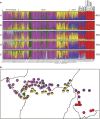Unexpected pattern of pearl millet genetic diversity among ethno-linguistic groups in the Lake Chad Basin
- PMID: 28121310
- PMCID: PMC5520532
- DOI: 10.1038/hdy.2016.128
Unexpected pattern of pearl millet genetic diversity among ethno-linguistic groups in the Lake Chad Basin
Abstract
Despite of a growing interest in considering the role of sociological factors in seed exchanges and their consequences on the evolutionary dynamics of agro-biodiversity, very few studies assessed the link between ethno-linguistic diversity and genetic diversity patterns in small-holder farming systems. This is key for optimal improvement and conservation of crop genetic resources. Here, we investigated genetic diversity at 17 SSR markers of pearl millet landraces (varieties named by farmers) in the Lake Chad Basin. 69 pearl millet populations, representing 27 landraces collected in eight ethno-linguistic farmer groups, were analyzed. We found that the farmers' local taxonomy was not a good proxy for population's genetic differentiation as previously shown at smaller scales. Our results show the existence of a genetic structure of pearl millet mainly associated with ethno-linguistic diversity in the western side of the lake Chad. It suggests there is a limit to gene flow between landraces grown by different ethno-linguistic groups. This result was rather unexpected, because of the highly outcrossing mating system of pearl millet, the high density of pearl millet fields all along the green belt of this Sahelian area and the fact that seed exchanges among ethno-linguistic groups are known to occur. In the eastern side of the Lake, the pattern of genetic diversity suggests a larger efficient circulation of pearl millet genes between ethno-linguistic groups that are less numerous, spatially intermixed and, for some of them, more prone to exogamy. Finally, other historical and environmental factors which may contribute to the observed diversity patterns are discussed.
Conflict of interest statement
The authors declare no conflict of interest.
Figures




Similar articles
-
Inference of domestication history and differentiation between early- and late-flowering varieties in pearl millet.Mol Ecol. 2015 Apr;24(7):1387-402. doi: 10.1111/mec.13119. Epub 2015 Mar 20. Mol Ecol. 2015. PMID: 25705965
-
Role of seed flow on the pattern and dynamics of pearl millet (Pennisetum glaucum [L.] R. Br.) genetic diversity assessed by AFLP markers: a study in south-western Niger.Genetica. 2008 Jun;133(2):167-78. doi: 10.1007/s10709-007-9197-7. Epub 2007 Sep 9. Genetica. 2008. PMID: 17828466
-
Diversity of wild and cultivated pearl millet accessions (Pennisetum glaucum [L.] R. Br.) in Niger assessed by microsatellite markers.Theor Appl Genet. 2006 Dec;114(1):49-58. doi: 10.1007/s00122-006-0409-9. Epub 2006 Oct 18. Theor Appl Genet. 2006. PMID: 17047913
-
Using genetic mapping and genomics approaches in understanding and improving drought tolerance in pearl millet.J Exp Bot. 2011 Jan;62(2):397-408. doi: 10.1093/jxb/erq265. Epub 2010 Sep 5. J Exp Bot. 2011. PMID: 20819788 Review.
-
Economics of Biofuel Production: A Case of Sorghum and Pearl Millet in India.Methods Mol Biol. 2021;2290:287-316. doi: 10.1007/978-1-0716-1323-8_19. Methods Mol Biol. 2021. PMID: 34009597 Review.
Cited by
-
New insights into the intraspecific cytoplasmic DNA diversity, maternal lineages classification and conservation issues of Tunisian pearl millet landraces.Plant Biotechnol (Tokyo). 2021 Mar 25;38(1):17-22. doi: 10.5511/plantbiotechnology.20.0831a. Plant Biotechnol (Tokyo). 2021. PMID: 34177320 Free PMC article.
-
VARIETAL IDENTIFICATION IN HOUSEHOLD SURVEYS: RESULTS FROM THREE HOUSEHOLD-BASED METHODS AGAINST THE BENCHMARK OF DNA FINGERPRINTING IN SOUTHERN ETHIOPIA.Exp Agric. 2019;55(3):371-385. doi: 10.1017/S0014479718000030. Epub 2018 Feb 20. Exp Agric. 2019. PMID: 33311720 Free PMC article.
-
Pearl millet genomic vulnerability to climate change in West Africa highlights the need for regional collaboration.Nat Commun. 2020 Oct 19;11(1):5274. doi: 10.1038/s41467-020-19066-4. Nat Commun. 2020. PMID: 33077747 Free PMC article.
-
Inter and intra cultural variations of millet (Pennisetum glaucum (L.) R. Br) uses in Niger (West Africa).J Ethnobiol Ethnomed. 2019 Aug 13;15(1):37. doi: 10.1186/s13002-019-0321-4. J Ethnobiol Ethnomed. 2019. PMID: 31409403 Free PMC article.
-
Biocultural diversity of common walnut (Juglans regia L.) and sweet chestnut (Castanea sativa Mill.) across Eurasia.Ecol Evol. 2020 Sep 24;10(20):11192-11216. doi: 10.1002/ece3.6761. eCollection 2020 Oct. Ecol Evol. 2020. PMID: 33144959 Free PMC article.
References
-
- Adjanohoun EJ(Ed.(1980) Contribution aux études ethnobotaniques et floristiques au Niger. Agence de Coopération Culturelle et Technique: Paris.
-
- Almekinders CJM, Louwaars NP, De Bruijn GH. (1994). Local seed systems and their importance for an improved seed supply in developing countries. Euphytica 78: 207–216.
-
- Allinne C, Mariac C, Vigouroux Y, Bezançon G, Couturon E, Moussa D et al. (2008). Role of seed flow on the pattern and dynamics of pearl millet (Pennisetum glaucum [L.] R. Br.) genetic diversity assessed by AFLP markers: a study in south-western Niger. Genetica 133: 167–178. - PubMed
-
- Altieri MA, Merrick L. (1987). In situ conservation of crop genetic resources through maintenance of traditional farming systems. Economic Botany 41: 86–96.
-
- Altieri MA. (2004). Linking ecologists and traditional farmers in the search for sustainable agriculture. Front Ecol Environ 2: 35–42.
MeSH terms
Substances
Associated data
LinkOut - more resources
Full Text Sources
Other Literature Sources

